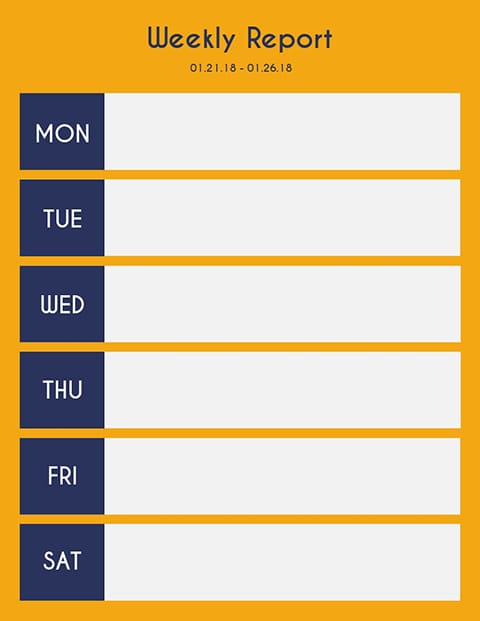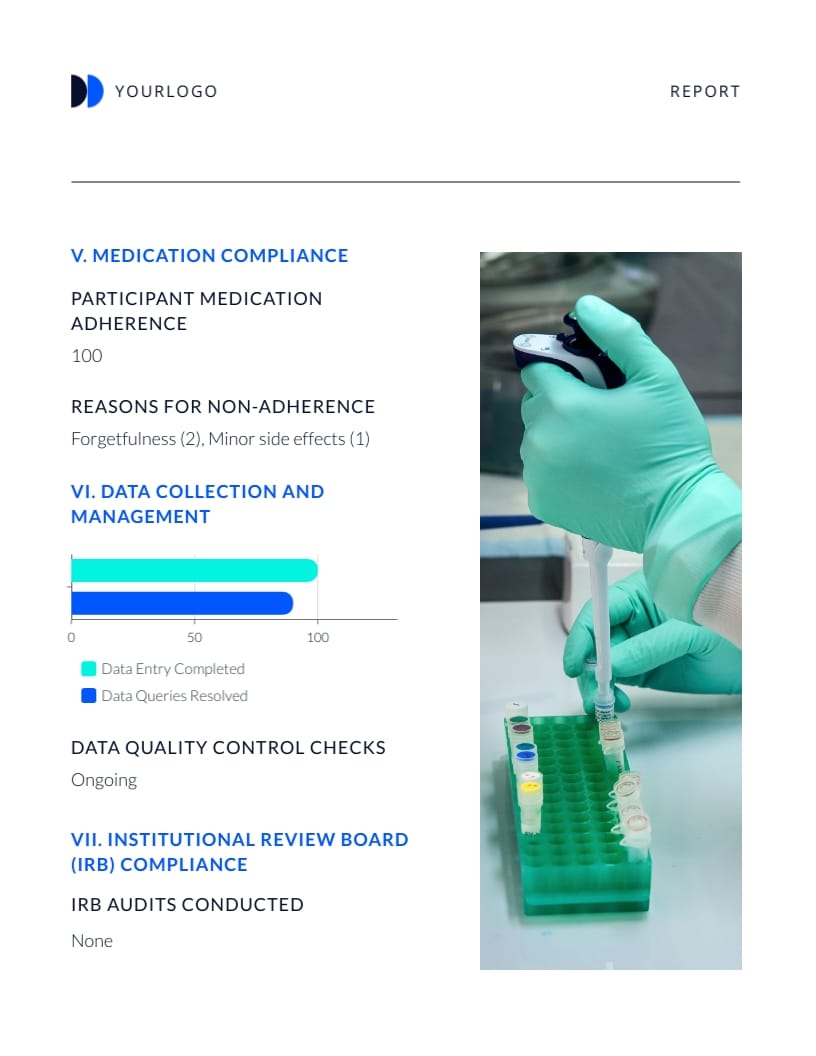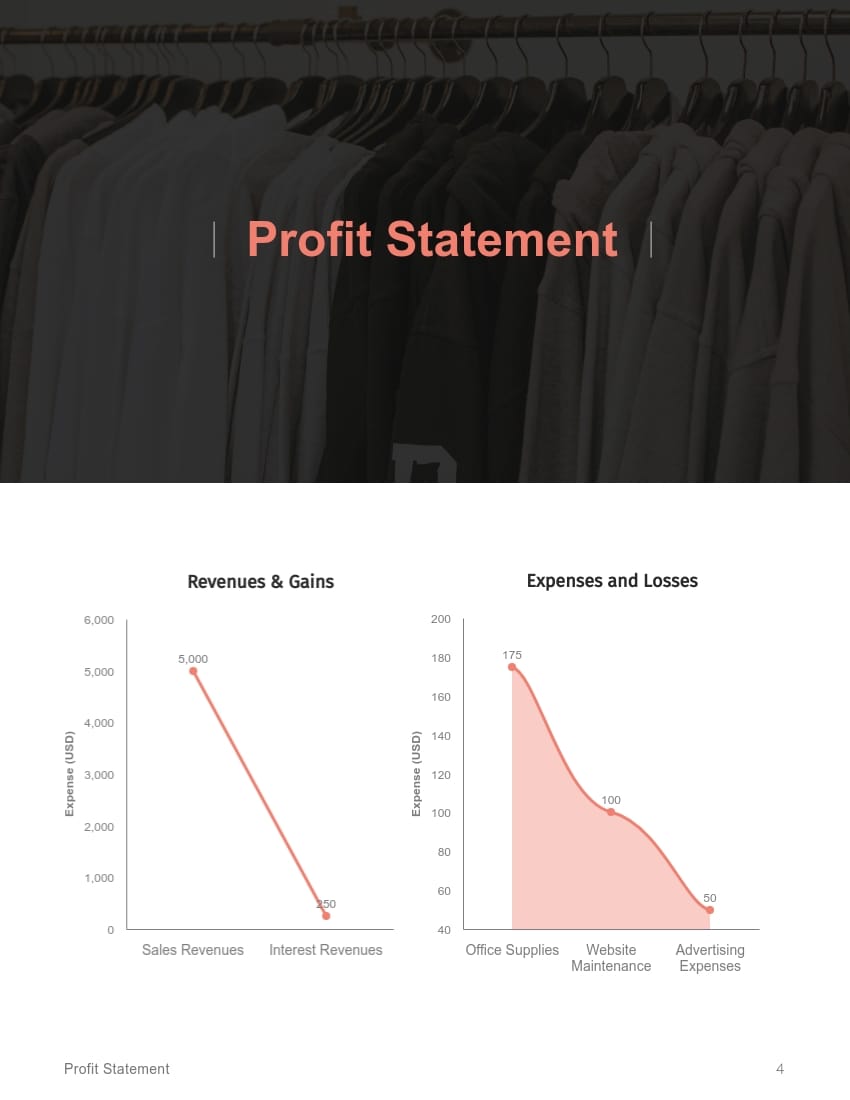![How to Write an Effective Weekly Report [Plus Templates]](https://visme.co/blog/wp-content/uploads/2020/02/Header-5.jpg)
![How to Write an Effective Weekly Report [Plus Templates]](https://visme.co/blog/wp-content/uploads/2020/02/Header-5.jpg)
A weekly status report is a complete overview of your week at work, covering projects you've completed, ones that are still in progress and upcoming plans for the future.
Ready to learn how to write a weekly report?
In this guide, you’ll learn what a weekly report is, how to create one, and get access to templates you can use immediately to write your own report.
Here's a short selection of 8 easy-to-edit weekly report templates you can edit, share and download with Visme. View more templates below:








Just as annual reports dive into a yearly review, weekly reports cover a complete review of your week. These look into:
So you’re willing to give a snapshot of your week. The real question is: why bother?
From an employer’s perspective, a weekly status report gives a quick look at what his or her employee is doing.
Is he secretly binging on Stranger Things (something I once noticed the receptionist over at a physiotherapy department doing while I waited for my receipt), or is he actually getting some work done?
The report also shows how the employee handled challenges that surfaced. And how far along a project has come under him. All this gives the manager an idea of employees’ strengths and weaknesses.
He then assigns other responsibilities based on these observations. Put another way, weekly reports help the management make informed decisions regarding assignments, operations, employee training and development.
On the flip side, the employee can get an idea of their role in the progress of an ongoing project. A weekly report also better describes how they’re pacing things. Additionally, they can learn how to get better at their job.
Want to create your own weekly report to share with your boss and/or your team? We've got nine great templates to help you get started.
Browse our selection below and choose an ideal template for your weekly report needs.
If you’re looking for something faster than a template, use the Visme AI Document Generator and create a report (or any type of document) from a text prompt. Input information about what you’re looking for and what you need in the prompt, choose a visual style and let the AI work its magic.
Need to provide a quick at-a-glance overview of your weekly tasks? Use this weekly reporting template below to speed things up by only adding important or top-priority tasks to tackle for each day of the week.

Need to share updates on a major project you're currently working on? Share the progress with a timeline and synopsis in your weekly report, as you see in the example below. For details that remain the same across each weekly report, you can use Dynamic Fields to ensure they appear on all your reports. Not to mention automatically update data across your report and other projects in your repository.





Looking for a report that gives status updates about budgets and expense breakdowns? This template has what you need. Connect the pie chart on page 4 to a live data stream on a Google Sheet and let the data update regularly and automatically. If you need more, Visme has a wide range of expense report templates for you to browse until you find one to suit your needs.





Get creative with your report format by customizing this infographic template. Include charts, data widgets and bullet points sharing any analytics and other updates you might need to present.

Break down your weekly report updates into a table like the one below to easily represent the sections you've worked on each week. Customize this template to fit your own needs, or use it as is if you need to share your own content ideas, competitor analysis and keyword research.

This is another one of our weekly activity report templates, perfect for showcasing the best-performing content, sales emails, social media posts and more from the week.
Remember that social media reports should always be used to keep an eye on trends in high-performing content so you can adjust your strategy accordingly.

Use this weekly updates template for a clinical trial with your medical investigation team.
Track issues like participant enrollment, study visits and assessments, adverse events, safety, medication compliance, data collection and management, milestones, progress, budget and resource allocation, challenges, mitigations and goals.





Work with your team using workflows to assign slides and sections to the people in charge of them. Keep track of what’s ready or still needs doing by setting due dates in the content calendar.
A weekly report template like this is the perfect way to summarize your work throughout a week, no matter what industry you work in or what your day-to-day tasks look like.
Not only that, but you can use the lines at the end to share your action plan for the upcoming week and what your team can expect from you.

Need to show off a few KPIs using charts and graphs? This template is the perfect starting point. Adjust any of the existing graphs or data widgets to fit your data using Visme's 40+ available data visualization tools.










Manage your team’s activity week by week with this project weekly report. Celebrate accomplishments, track pending work and be clear with the budget status. Finally, showcase KPIs to keep track of your team’s performance.
If you're a manager who needs to keep track of how your team keeps up with projects and major tasks, use this employee weekly status report to track performance. It’s customizable to suit your industry, department or project needs.
You can take it a step further and turn it into a weekly management report for managers and leaders who also need to report to various departments and high-ups as well. Helping to provide a birds-eye view of departments working on high-priority projects at all times, keeping deadlines in check.





During major campaigns, busy seasons, etc., you might want to keep a close eye on how your sales are doing. Putting together a weekly profit statement can be a great way to keep everyone up-to-date with how the company is performing as a whole.
Use a template like the one below to easily insert your own content and updates.





Your team’s email campaign has yielded great weekly results. It’s time to share the data with stakeholders with easy-to-grasp data visualizations and visual storytelling arcs. Use this report template specially designed for email campaigns like yours. Send out weekly reports with the latest metrics and the most engaging visuals.
When you’re ready to share this template, use Visme’s sharing options to send a shareable link. With it, you can decide who can see it, edit or allow comments on it for discussion.
The best part is that when you share your report online, you can make real-time changes to keep it up to date with the latest task added or one you might have forgotten to add.










Looking for weekly progress reports to track your team’s customer service efforts? Use this template to set goals and KPIs that will help your customer service reps improve their work week over week.
Make your report even better with generated text that supports the content using a text prompt. Use the Visme AI Writer to help you craft descriptions, blurbs, short explanations and catchy headings to make your report not only practical but also interesting.
A weekly report is an internal glimpse into your week, and it serves a good purpose. You can present it to your team lead or manager and showcase what your workload was like during a particular week.
Unlike a daily report, weekly reports help to get a better view of whether your workload is overwhelming, if your actions were results-focused, or if you might be missing key opportunities to focus on more important rather than urgent tasks.
But between doing the actual work and creating a weekly report from scratch, you might find it as another item on your to-do list.
Instead, use one of Visme’s weekly report templates. These pre-made templates will help you not only to track your task but you’ll be able to present your weekly status report in style.
For now, let’s dive into how to effectively capture what to add when you’re filling out your weekly status report.
:
First things first – outline your report’s objectives before you set to work.
Here’s the part where you decide what’ll go into your weekly status report. What exactly does your management want to see?
Pro Tip: You might want to check in with your supervisor if you’re not clear about what goes here.
For instance, folks over at the team collaboration app Chanty have their weekly report objectives in order. Their aim is to share weekly KPIs.
Their CMO, Olga Mykhoparkina shared, “For us in the marketing team, we share our organic traffic, new links, new blogs and publications and anything else that came up during the week.
These are all outlined in advance and every team member knows exactly what they need to present.
So the general objectives are to:
Other purposes might include a weekly KPI report, a project status report or a profit statement.
Another thing to do before you put pen to paper is making sure you’re crystal clear about your responsibilities.
Are you responsible for working on project A? Or are you supposed to contribute to project B’s phase II as well?
If you think your role relates to contributing to various tasks, you’re wrong. That’s too wide a scope to cover and present in a weekly report.
So you need to make sure you’re clear about the project you’re handling and what the definition of success is for the project. Don’t have an answer? Talk to your boss.
Knowing your role is essential to putting together the perfect weekly project status report.

It’s easy to assume that slapping a few paragraphs on a paper makes a befitting report.
This is why you need a layout for your weekly status report to ensure your report is short, to the point and visually stunning.
Since we’re covering weekly reports here, you’ll need a layout with separate sections dedicated to each day of the week. A weekly report template can give you a pre-baked layout.
You can get creative with your format too. For instance, you can turn it into a visual infographic . Customize a report infographic to create a weekly report infographic your supervisors will love.
Or you can create an interactive infographic weekly report. We created an annual interactive infographic annual report for Visme . Take a page from our book and prepare your own interactive infographic weekly report.
Other than this, if you’re working on a large project, you can divide the weekly status report into sections.
Let’s say you’re working on starting a blog for your company. You could divide your weekly report into 3 sections: ideation, competitor analysis and keyword research.
Present your weekly status report divided by 5 working days that each address the 3 goals and what you did to further them on each day. Alternatively, divide your weekly report by the 3 areas you’re working on. Under each, share what you did during the week.
Now that your objectives and role are clear and your layout ready, you can start writing.
Just keep these three writing tips in mind:
Want to ensure your weekly status report doesn’t miss any important details?
Include the following:
The top management can’t remember everything all the time so it’s best to always give a summary of your project’s objectives.
The aim here is record keeping. By dating your reports, you’re making it easy for your manager to thumb through reports in chronological order should an issue poke its head.
Since you’re giving a weekly outlook here, make sure you talk about what you did each day of the week.
Be sure to title your report with your [role] + [the report’s status]. Let’s say you’re a Communications Manager so you’d title your report as Communications Manager Weekly Status Report.
Outline what you had on your plate. If you don’t give the management an idea of what you had in the pipeline, they wouldn’t know how to measure your progress.
You can also categorize your tasks under, ‘in progress,’ ‘done’ and ‘delayed.’
Don’t forget to highlight progress and the goals achieved.
In this regard, it’s best you discuss metrics with the person you report to beforehand. That way, you’d know how to explain your progress.
For instance, you’ve covered 75% of your task. Your manager can only understand this if you’ve discussed previously that you’ll notify your status by noting the percentage.
Note issues you encountered in your week while also providing suggestions for any steps that the management can take to ensure smooth workflow.
Lastly, tell what is planned for the coming week. This gives your manager an idea of what you’d be covering so he can map your future steps based on your deliverables.
With this, you know how you can write an awesome weekly status report. Now onto the next section for ensuring your report is beyond awesome.
Follow these best practices to outshine your report.
A single-page document is enough to sum up your week while respecting your readers’ time. Add a report cover page to spice up your weekly report design.
Although you may not find the space to add visuals, you can always strategically use them in your report. Perhaps show a chart demonstrating how much of your project is completed.
Whatever you do though, make sure you don’t use complex graph types here because they aren’t very readable and you won’t have the space to explain the data.
Graphs such as pie charts are, however, easy to understand so you can experiment with those in your weekly status reports.
It’s a task that shows up every week so investing hours is futile. Ideally, use a weekly report template to give your report a permanent structure and speed up your report writing process.
If you’re using a weekly report template, you can fill it in before the end of each day when the day’s details are still fresh.
Visme's Weekly Report Maker makes it easy for you to edit and customize a weekly report to fit your job. Once you’ve tailored the content to fit your role, all you have to do is pop in edits each week.
Lastly, before we wrap this up, let’s leave you with report writing mistakes you need to avoid so your report is ready to shine.
Your weekly report structure should show clarity of thought. And it works both ways. You make writing weekly status reports less cumbersome and time-consuming for yourself. Because you already have a layout in place, you don’t need to start from scratch.
On the flip side, a base structure makes your weekly report easily consumable for your reader. It also sets expectations clearly from the outset.
Readability relates to making your weekly report easy to read for your target audience, whether that’s your manager or someone else.
Think of it like this, a block of words can be tough to read:

But short paragraphs and bullet points with subheadings or icons make your content snackable.
For instance, this weekly report template page from Visme makes sure your content is easy to read by providing a highlight section alongside the major accomplishments that were completed throughout the week.

Alright, so you get how important readability is. The question now is – what can you do to make sure your weekly status report is easy to read?
Design also plays a crucial role in making your weekly status report readable.
Wondering how? With the right colors and whitespace.
You’d be surprised to know that colors can actually encourage or discourage people from reading your content. That’s how powerful their impact is . Red, for example, is known for drawing people in and making them excited.
Meanwhile, pastel colors are trending, so you can use them to make an epic weekly report page design.
These also leave a minimal effect, a creative way to design your report to wow your reader.
Here are more ideas you can grab from this guide on creative presentation ideas .
This also goes with the name of negative space and is the space between your paragraphs, graphs and other visuals in your report. Too much or too little of it can disturb reading experience. So you’ve got to be careful.
Can’t play with color because you’ve got to stick with office colors? Perhaps you’re sending in a weekly status report to your client and can’t deviate from your branding ?
Either way, no worries. Just tweak the color with Visme as each template is customizable so you’re free to tweak not only the color but also the font and other design elements.
Plus, you can easily upload your brand colors and fonts to your Visme Brand Kit to make branding simple.
Without giving a gist or executive summary that includes your next steps, you run the risk of breaking the momentum.
So elements like data, a summary of the week, a quick recap of the past and what’s in next week’s to-do board are good for keeping things on track.
Needless to say, the problem with these errors is that they ruin impressions in seconds. But you can always prevent these by:
Still, have a few questions when it comes to weekly reports. Dive into this FAQ section to learn more:
A weekly report template is a customizable document that allows you to give a detailed weekly report on what activities or projects were finished, are in progress and are to be completed in the future.
A template offers more flexibility as it can be duplicated, used to maintain consistency in brand or formatting, and is easier to use.
A typical weekly report consists of tasks completed during the week, those currently in progress, and those planned for the future. It should include dates, updates, changes, deliverables, tasks, results, challenges or roadblocks.
However, it's important to note that the format will differ depending on the type of weekly report being created.
For instance, if you're using or creating a template, a weekly business report template might be formatted to present tasks at a high-level overview from various departments, including the assignment or multiple team members needed for each task. In contrast, an employee weekly report template would be simpler, consisting of basic tasks, as it is geared towards a more individual approach.
A weekly report should be one page. It should essentially serve as a weekly summary of tasks or assignments. This allows the writer to provide clear and concise details about their tasks while allowing the reader to quickly review them without the hassle of skipping through multiple pages or fluff.
If you or your manager needs a more detailed report on tasks and assignments, it would be best to create a monthly report instead. This type of monthly report writing allows you to delve further into details, challenges, and changes you or your team are facing, as well as the solutions to implement for the next month.
It’s always best to ask whom you’re sending your weekly report to about what format works best for them, as there are multiple ways to send a weekly work report. You can send your weekly report to a manager as an email or a Slack message. If they prefer a more professional approach, use a weekly work report template created with Visme.
Writing a weekly report doesn’t have to be hard. Now that we’ve gone through step by step you should be able to create and share with others confidently. Choose from one of our large resources of weekly activity report templates to get started.
With Visme, you can go from idea to successful execution, not just for your weekly reports but for business reports and other types of reports as well.
With team collaboration features, integrated tools like Slack or Monday.com, and in-depth project analytics, to name a few, you’ll be able to give yourself and your team a competitive edge in the workspace and your industry.
Interested in seeing what Visme can do for you? Sign up and try Visme’s report maker for free today!